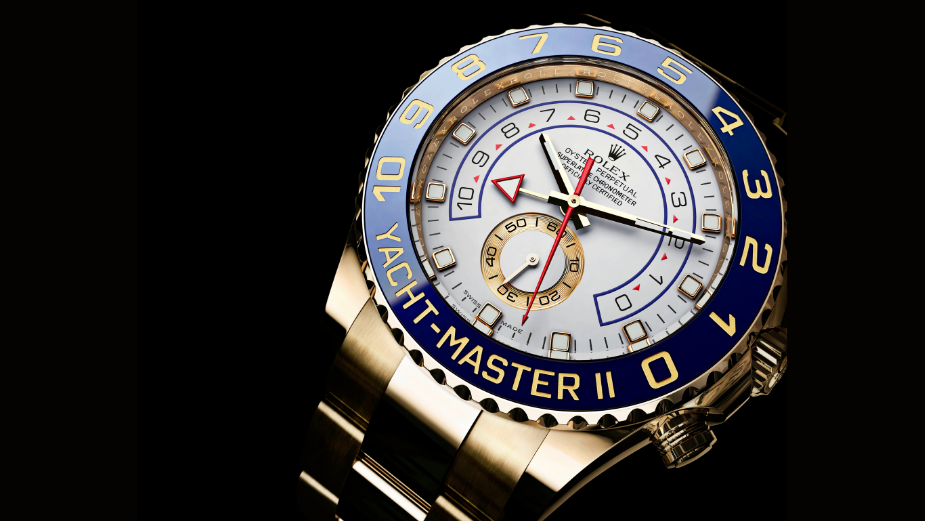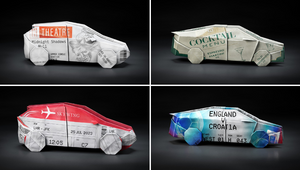
Product Porn: How To Get Consumers Drooling

The ice cold drops of condensation on a beer bottle; the bubbling hot cheese on a pizza; the glint of a watch as it catches the light; and the soft sheen of silk as it flows in the wind. All of these elements have the ability to capture our attention, and whether food, glossy tech, flashy cars or luxurious fashion, it’s visceral visual cues like these that have the power to get consumers drooling.
But replicating these intricate details on screen or in print is far more complicated than it may seem. To achieve our idea of product perfection and bring these items to life, brands rely on the incredible technical skills of CGI artists who study these products at microscopic level in order to craft indistinguishable, photorealistic copies of the real thing. It’s a talent that comes with a huge amount of experience and practise.
With over 20 years of experience crafting content across a vast range of sectors from tech and automotives to food, drink, fashion, health and more, creative production studio Taylor James is well versed in the art of photorealistic CGI. Executive creative director Jay Harwood explains: “There are multiple benefits for creating a motion or still campaign in CG. You can create camera moves that are not possible with real cameras; you can repurpose the product for multiple outputs, seasons, or spec options; and when it comes to showing off what's inside, you can animate all of these things to do anything you can dream up. But not everybody has the eye for it. We have specialists that have trained for years in making products look great.”
“Most of our artists have traditional backgrounds in areas such as photography or video,” adds director of creative production Mark Knowles. “They are used to working in real life scenarios with natural and studio lighting. Working alongside photographers they learn so much about the rules of realism. So much of that traditional knowledge transfers into the digital world. Their eye for realism, light, shape, colour and how to bring that out in a digital image and make a product sing ensures that the consumer can reach out and touch it, even through a digital screen.
He continues: “Realistic CGI becomes particularly powerful in a time when online consumers have lost the ability to touch a product before they buy it, given the decline in retail outlets on top of various lockdowns. CGI helps an audience see and feel a product in a way you can't with photography. For example, exploding a product in CG gives an intimate insight into its inner workings - it becomes more familiar, and as artists, it's our job to convey the quality and craftsmanship that the product teams have poured into development.”
Products Under The Microscope
To create the perfect CGI copy of a product, you must first get to know it like the back of your hand. From the way it catches the light and the way it feels to the touch, to the way it moves and how many parts it is made up of.
“Reference is critical. One of my first jobs at Taylor James was our Rolex campaign. I would sit and look at every micro facet of each watch daily,” reveals Mark. “Seeing how materials react to light, their texture, the surface relief or even how a material feels to the touch can often help an artist interpret how to display it in CGI. So many of the pieces we produce today have roots established years ago. We always try to re-purpose material libraries we build in CGI and then continue to push and improve their realism as technology allows and new projects come in.”
For executive creative director Brendan Haley, who specialises in the food and drink sector, the products need to look good enough to eat. “It has to look completely real and authentic in order to appeal. Where possible, we try to source the real products so we can take our own close-up reference photography and get a better feel of the surface textures and details that we need to replicate in CGI. We have to pay a lot of attention to the texture details at a macro level - even a glass bottle actually has a bumpy textured surface when you get up close. Things like ensuring the glass thickness is correct and the liquid inside is contacting the glass in the right way are all critical to achieving that high quality and realistic look.”
Using a Digital Brewery™ tool Taylor James is able to create a suite of products, such as bottles, cans and glasses, to a predefined brand look. This includes different camera angles, lensing, lighting setups and environments as well as a huge library of different spritz and drops that can be applied to the product. “We can create a super chilled look with fine condensation (a preference in hotter climate markets) or larger droplets running down the product for a more refreshing look,” Brendan says.
In the field of automotives, the product often doesn’t yet exist. Creative producer Frederik Soares says: “For launch packages, we are generally involved in photographing the pre-production models. There is such a high level of importance on every single visible piece of the vehicle that we ourselves have to become product experts and we have to understand the many layers of decision makers that we need to collaborate with. We essentially become the final gatekeepers to how the public sees these vehicles, and quite often how they see it for the very first time. Helping showcase a brand new model is not a task any of us take lightly.”
The Wow Factor
So what goes into elevating a product from just looking photorealistic to looking irresistible?
For tech specialist Jay, whose mission it is to make us lust after new headphones, laptops, phones and more, it’s all about “shape, shape, shape! With tech products you want to see every single curve or angle. Pin lighting accentuates corners and soft boxes create shading within the reflections to help showcase all of these details. Different faces of the product need to be separated, even if they are symmetrical and if you want something to really pop then push those white values. This combined with dynamic camera angles that don't distort the product but make it feel bigger or more awesome, get the buyer salivating. And in my experience, the final lighting of a product is the make or break of a happy client.”
Speaking to the specialists across different sectors, they all seem to agree - perfecting the lighting is key: “It’s the number one most important factor in making a vehicle look great,” states Frederik. And when it comes to CGI food, “The lighting and staging need to be heavily considered in order to make the food look as irresistible and as appetising as possible. It has to grab the viewer’s attention, trigger their taste buds and make them want to buy the product,” Brendan says.
For fashion specialist Mark: “form and function are also critical. You must have a stylistic integrity which is on-brand but also a practicality about showing the features of the product, especially in an age of online shopping. It must entice and excite from afar. We recently completed work for Uniqlo where the texture, material, style and fit were critical to conveying the quality of the product. We worked directly with the brand to ensure we had a balance of lifestyle shots involving key fashion influencers and those beautifully lit, macro close shots of the textures on the down jackets showing its moisture repelling capabilities.”
He adds: “Music is sometimes a forgotten art; it can add tremendous value to a piece but given it usually happens towards the end of a production it can sometimes be an afterthought. Where possible, we always have the music drive the pace, tone, or cadence of an edit. Even better if that music can be an original score. Sound design is another element beyond just laying down an audio track that can bring a much more intimate experience. With more people purchasing online, we need to evoke the best emotional response and sound design can give a consumer another sensory experience that alludes to a product's quality, function, or lifestyle. For Rolex we laid down audio which embodied the watches history. For example, for Yacht Master we evoked the sounds of the sea, a balance of crashing waves and the sounds of the sea. Having the edit and audio working in tandem provides the most holistic result. It's critical that the music feels integrated with a final piece otherwise it can be jarring. ”
“Overall it’s about setting the mood, whether that’s with music, motion graphics, or other added elements like camera path. It’s super important in controlling the narrative and focusing the consumer's attention,” Frederik adds.
“Absolutely - for clients, features are obviously what they want to sell, so it's up to us to embellish with design and movement to engage the audience,” Jay says. “I'm always a fan of connecting the shots up: as one shot exits one way, the other comes in to keep the eye’s journey fluid. Big cinematic moves that almost make a product feel architectural are cool. But that's not to say that you can't have a much more cutty edit with multiple angles shown quickly too - it gives the product a different personality.”
Mastering The Deliverables
Not only must a CGI artist work on making products look their best, but they have to consider creating them in all different formats too - from TVCs and billboards to social media, one campaign can command a huge range of deliverables. “Nowadays, the ‘toolkit’ approach to production is becoming more pertinent,” Mark explains. “We traditionally create 16x9 for TVC, 1x1 and 9x16 for social, and then need to develop assets for out-of-home in billboard resolutions on top.”
And it doesn’t stop there: “Once we have those masters, we tend to adapt those files to digital banners as well as homepage takeovers,” Mark says. “It really does stretch the gamut of media channels. Even capturing audio for radio on set sometimes.”
Brendan elaborates: “We have to ensure outputs work for many different formats of media. Usually this means checking the tallest and widest crops and ensuring the resolution within those crops is suitable for the end media. In some cases we will provide a modular kit of parts, with elements on layers to make it easy for adaptation further down the line.”
As the variety of media channels and platforms continue to grow, Frederik predicts that “fully interactive and fully customisable is how this industry will be progressing. Real-time rendering of stills and motion that the consumer can configure to match their customised builds. This enhances the customer journey and builds a stronger connection between consumer and product. With certainty I can say this will become an essential element in how the automotive customer’s journey, and the assets required for it, will progress in the very near future.”
“If I was a client or agency reading this I would strongly suggest knowing your deliverables before you start,” Jay suggests. “When it comes to creating a HD film and then asking at the end if we can make a portrait video for social content, you'll get a lot of silence on the phone. That one sentence sends shivers down my back, as you never really compose a scene with vertical in mind unless asked otherwise, and you can only crop a product if it is not orientated horizontally.”
He continues: “Knowing this upfront can save you time and money and a lot of last minute headaches explaining to the client that we have to create a new shot specifically for the social video as the current crops out half their product. Though I did like one video somebody did, where they asked the viewer to rotate their mobile device to view the video. Instantly you have engaged them and you have your product really big on a social feed.”
Weaving Together A Story
As a fully integrated production company, Taylor James is able to deliver design combined with VFX and expand it with live action directors and photographers who bring a larger story to the campaign. “If you can connect to an audience with visuals and a narrative that represents the product and thus yourself, you're onto a good project,” Jay highlights. “For a lot of people, their laptop, headphones, and phone say something about them, so connecting that up with the brand will capture the imagination of the viewer. We've made commercials that lean more heavily into how real people use the product, or used comedy to push a great metaphor, for example. ”
“With automotives we’re often tying together a brand’s overall identity with a specific model. For example, a brand could be looking to position themselves as performance oriented but need to convey that for a large SUV,” Frederik explains. “This is when we start looking at subtle hints within an environment to tell the story, whether that’s a windy road in the distance or a camera angle to make the vehicle feel wide. Building out mood boards and reference images is a great way to align teams before diving into finding locations. Often the agency or brand has a mood board that they provide us, but we like to counter that with a mood board of our own to help expand creative vision and provide options as well as bringing everyone’s thinking into alignment.”
Fashion specialist Mark comments: “Often, we think about how to make something look as real as possible but that can be at the expense of the actual consumer experience. The strongest pieces have the balance of form and function. The best work we do is when a consumer doesn't realise it’s CGI and they also find the content relatable; they can envision themselves using the product in their everyday lives. With L.L.Bean, not only did we take a deep dive on the technical aspects of the product, which we showed in amazing CG macro moments, but we also did a live action shoot in Buenos Aires which helped sell each clothing item’s specific lifestyle scenario.”
He concludes: “I think there's a trilogy of things people love to see in product pieces: close ups of materials and features so they can reach out and touch a product virtually; contextually relevant to their lifestyle and displayed in situations they find personally relevant; and aspirational imagery which they can see themselves in stylistically. If you can hit those three points, the path to purchase becomes far more effective.”













